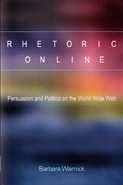Warnick notes that while interactivity is important, there is surprisingly little agreement about what it is or where it resides. Is it in the media technology, the user's individual perceptions, or perhaps somewhere in the contexts of a rhetorical situation? To find a way through such questions and to set up a useful heuristic for this chapter's case studies of online political discourse in the 2004 presidential campaign, Warnick draws on Sally McMillan's tripartite typology of the forms of interactivity. In brief, McMillan's typology classifies interactivity as user-to-system (such as clicking on hyperlinks, adjusting displays), user-to-user (such as chat or comments on blogs), and user-to-document (such as voting in online polls, submitting questions to be answered, and contributing content).
With this three-part schema in place, Warnick examines how and why interactivity was used on two websites from opposite ends of the American political spectrum—MoveOn.org and GeorgeWBush.com—to persuade audiences during the 2004 presidential campaign.
No summary in a review can do justice to Warnick's close analysis of the different types of interactivity and the different contexts and purposes of these sites' uses of interactivity. In general, though, Warnick establishes that MoveOn.org (at least during the period of her study) blended all three types of interactivity by allowing site users to express their opinions about political issues, coordinate meetings and other activities to take place offline, and even to contribute site content such 30-second digital films with anti-Bush messages.
As for GeorgeWBush.com, Warnick demonstrates that interactivity was used for different purposes, purposes that contextualize the rhetorical uses of interactivity on the site. Bush was the incumbent president with a well-financed campaign. Thus, his campaign had both the desire and the means to disseminate a focused political message and had no need to solicit content from amateurs. Users could engage in user-to-system interactivity by streaming the same campaign ads that aired on broadcast television and in user-to-user interactivity such as organizing volunteer campaign activities and using the site as a clearinghouse for information.
Warnick argues that interactivity as a persuasive event highlights the importance of understanding interactivity through the lens of Burke's view of persuasion as intimately connected with identification. The types of interactivity that a site affords bring audiences together around a common vision of their values and identities, both by celebrating what "We" stand for and attacking what "They" stand for. Warnick's careful readings of these two Web sites show that not only does interactivity have consequences for public political discourse, but also that rhetorical critics must develop critical heuristics that are sensitive to "the specific communication context and the constraints and demands" of the rhetorical situations in which Web artifacts are created (90).
Warnick's approach that examines two ideologically separate websites in a particular political context and historical moment offers a model for future rhetorical theory and criticism of interactivity as a persuasive resource, both among websites that are ideologically opposed and perhaps also among websites that are ideologically aligned but that take different approaches to their shared political goals.
In her next case studies in Chapter 5, Warnick moves on to examining the rhetorical implications of intertextuality in Web-based public discourse.
